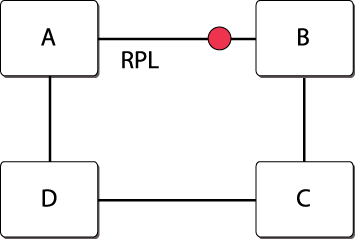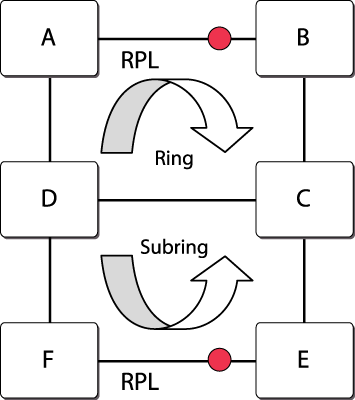The basic concept of G.8032/ERPS (Ethernet Ring Protection Switching) is that traffic may flow on all links of a ring network except on one link called the Ring Protection Link (RPL).
The RPL owner is the node that blocks the RPL, and the other node of the RPL is called the RPL neighbor node. All other nodes are called non-RPL nodes. When a link fails, the RPL owner unblocks the RPL to allow connectivity to the nodes in the ring. The G.8032/ERPS rings utilize a channel (dedicated path) for carrying their control traffic which is the R-APS messages (Ring Automatic Protection Switching).
The ring protection architecture relies on the existence of an APS protocol to coordinate ring protection actions around an Ethernet ring, as shown in Simple Ring with RPL, RPL Owner, RPL Neighbor, and Non-RPL Nodes.

More complex topologies include ladder ring networks which are called sub-rings in G.8032 terminology. In these networks, there could exist one or more rings and sub-rings which complete their connectivity through the interconnected nodes of the ring(s). Multiple ladder networks are supported only if the following conditions are met:

Note
One important aspect of sub-rings is that they complete their channel through the virtual channel (when using the virtual channel mode), which can span the network and cross the sub-ring boundaries. This entails that the virtual channel is provisioned on all the nodes it spans across.In Ring and Sub-ring Network, the ring comprises nodes A, B, C, and D with links A–B, B–C, C–D, and D–A while the control channel for this ring has its own dedicated VLAN (Virtual LAN). The sub-ring consists of nodes D, F, E, and C with links D–F, F–E, and E–C. D and C are interconnected nodes. The channel for the sub-ring spans the links C–E, E–F, and F–D and their nodes while the virtual channel comprises the links D-A, A-B, B-C and D–C and their nodes. This means that the virtual channel for the sub-ring needs to not only exist on the interconnected nodes, but also on the nodes A and B.

When using G.8032 in networks, take care to design the virtual channel paths, since the VLAN provisioning has to exist on all the nodes through which the virtual channel can pass and which is solely dedicated to the sub-ring in question.
Sub-ring topology changes may impact flow forwarding over the domain of the other (interconnected) network, as such topology change events are signaled to the domain of the other network using the Topology Change signal.

 Print
this page
Print
this page Email this topic
Email this topic Feedback
Feedback